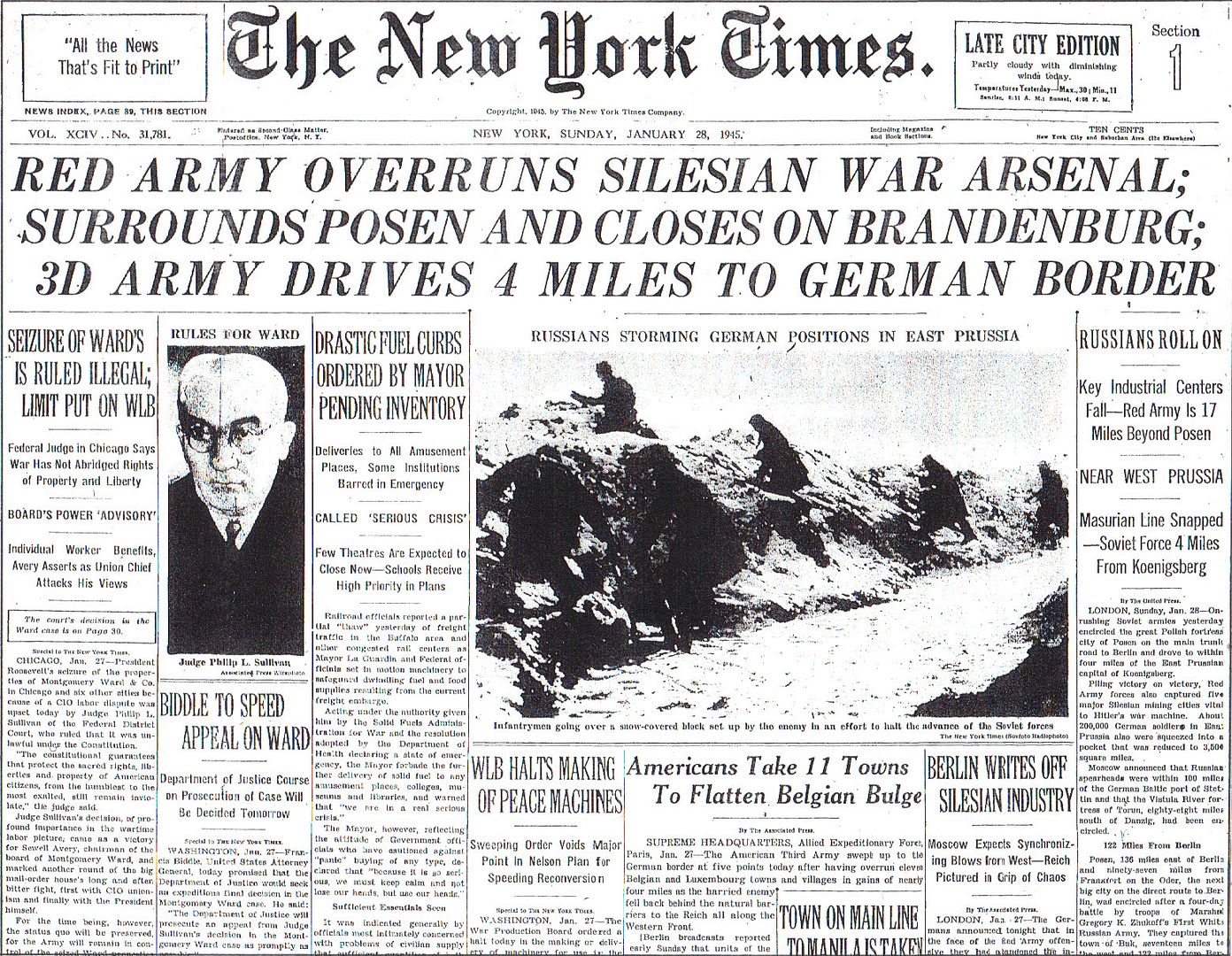
Posted on 01/28/2015 4:18:31 AM PST by Homer_J_Simpson

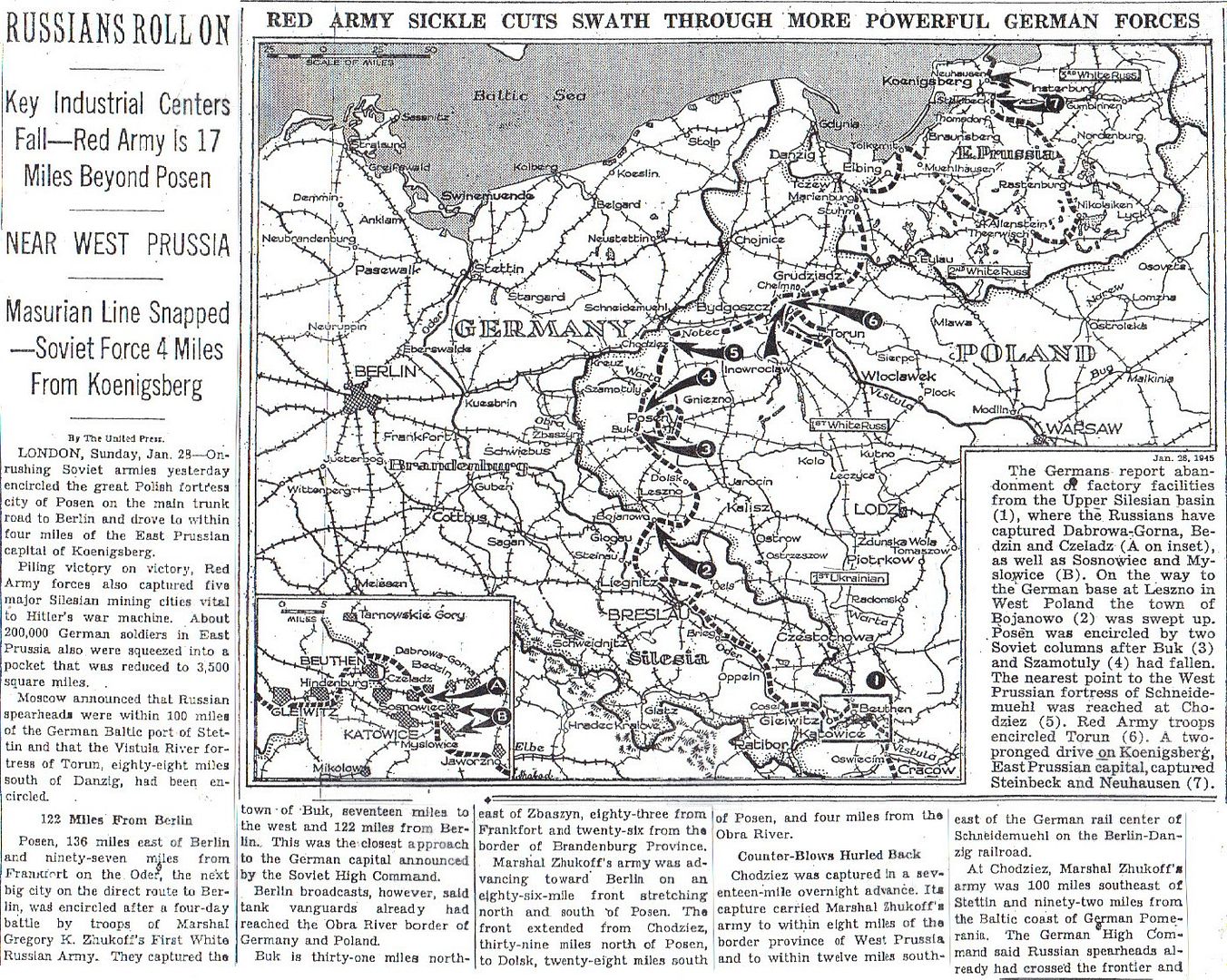


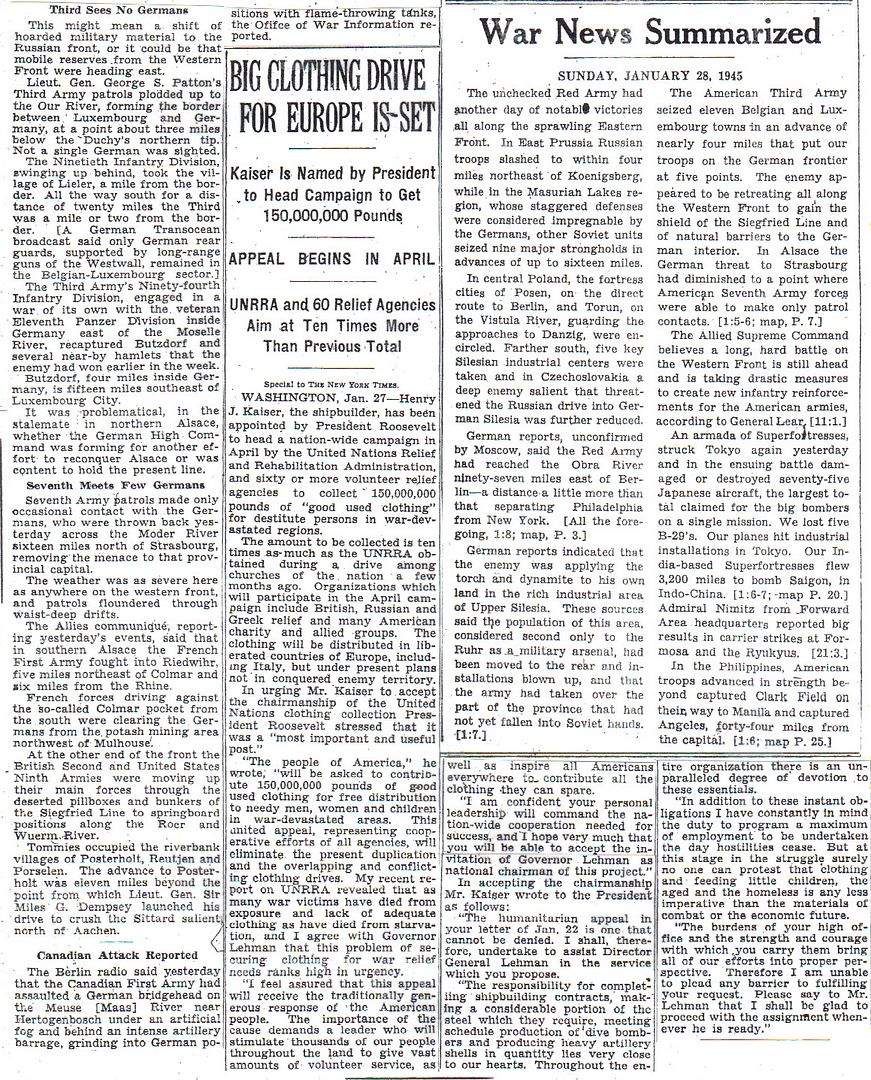

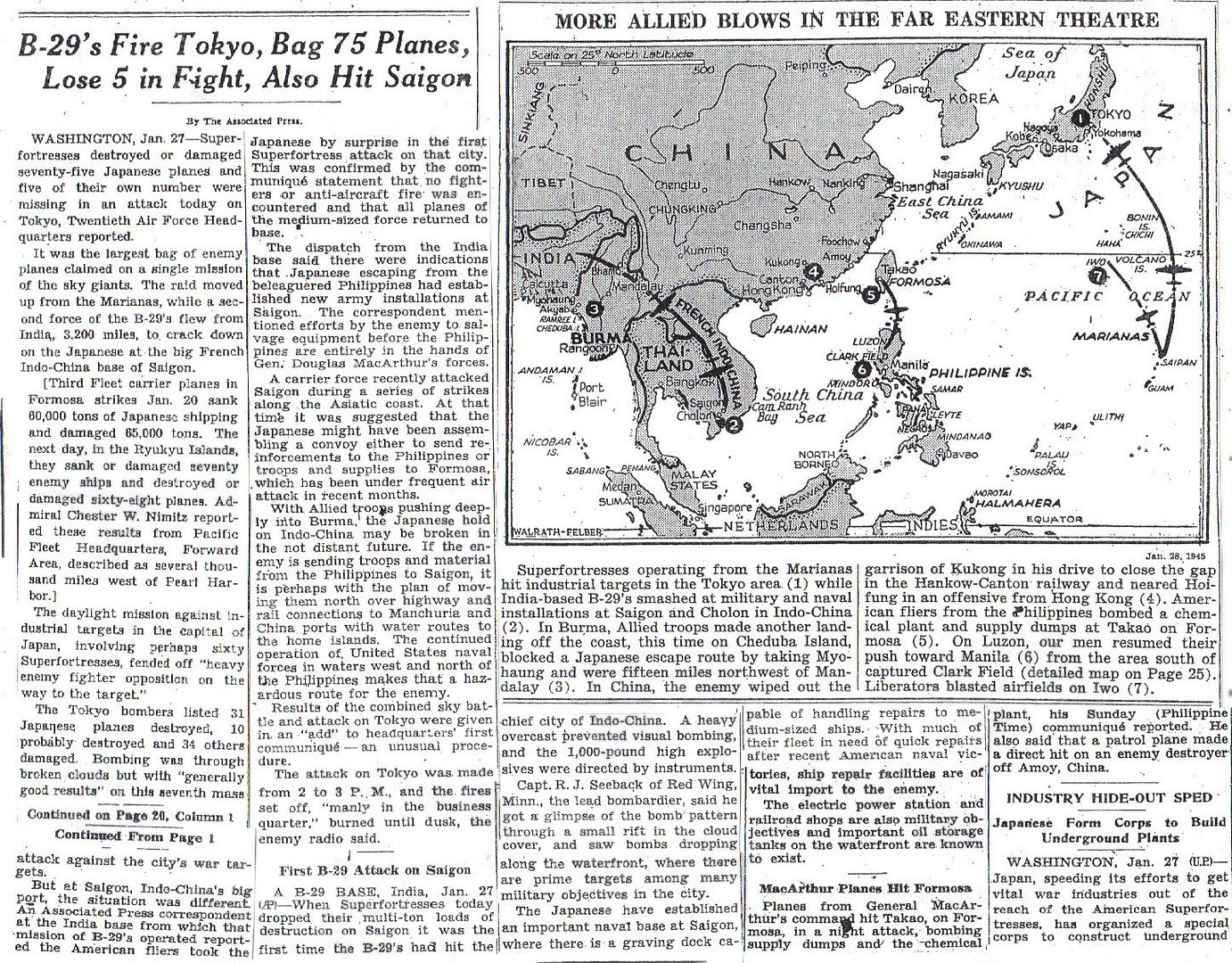
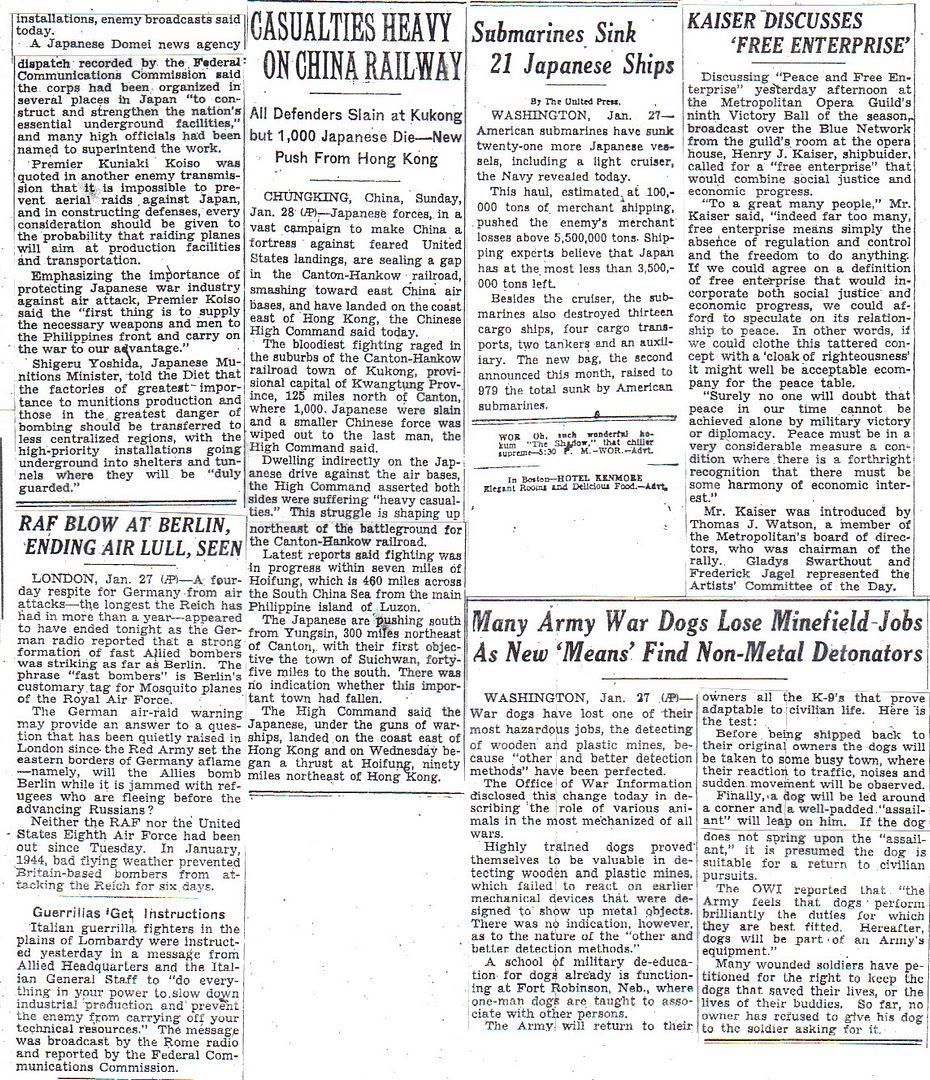
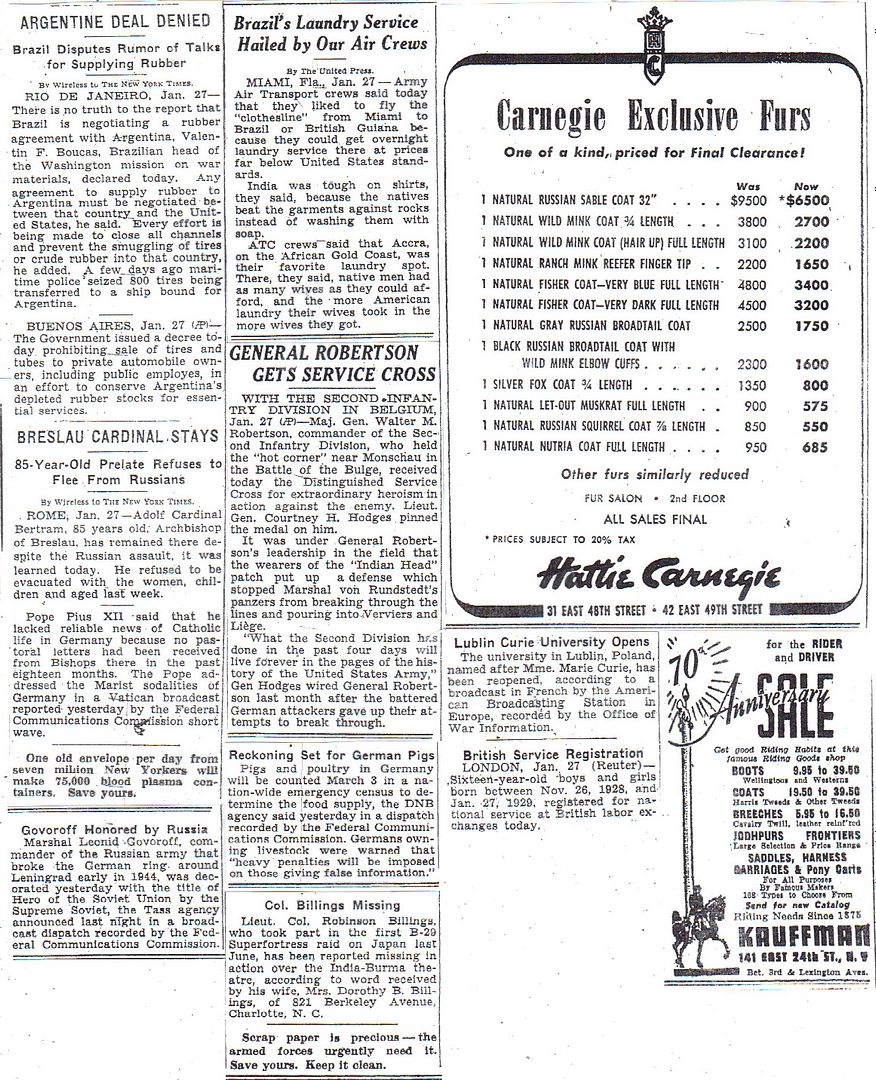
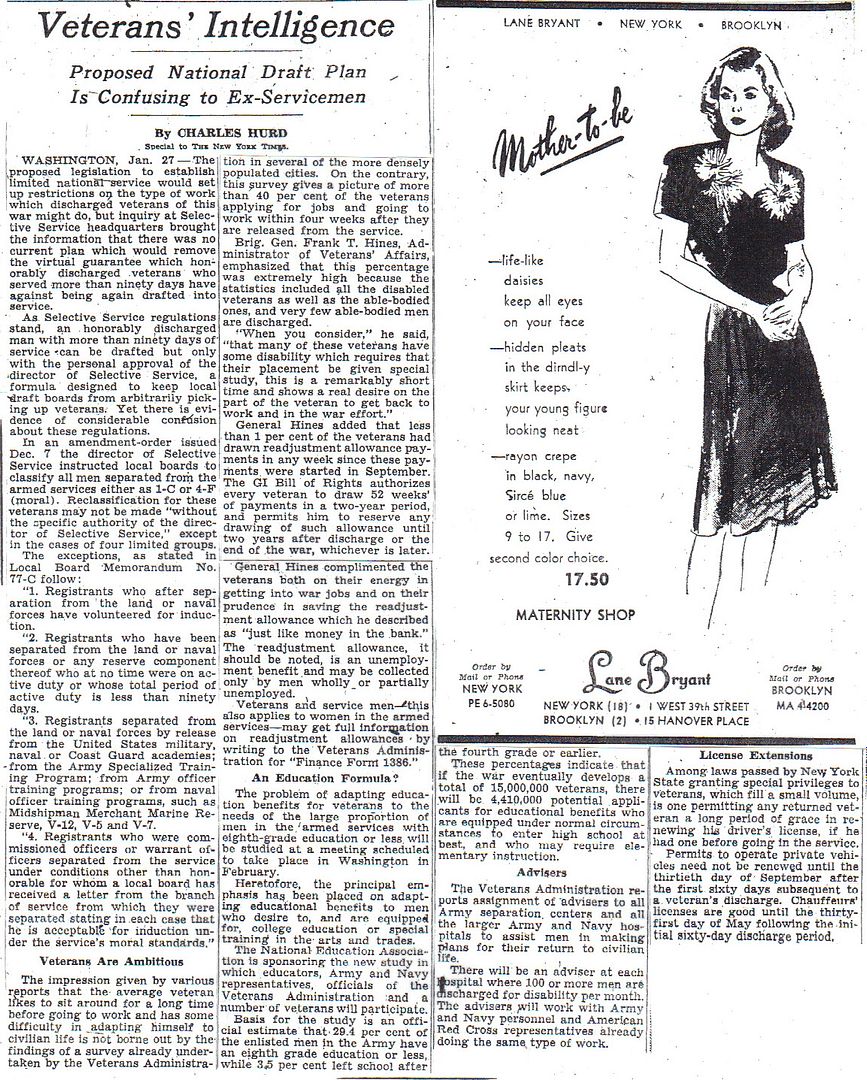

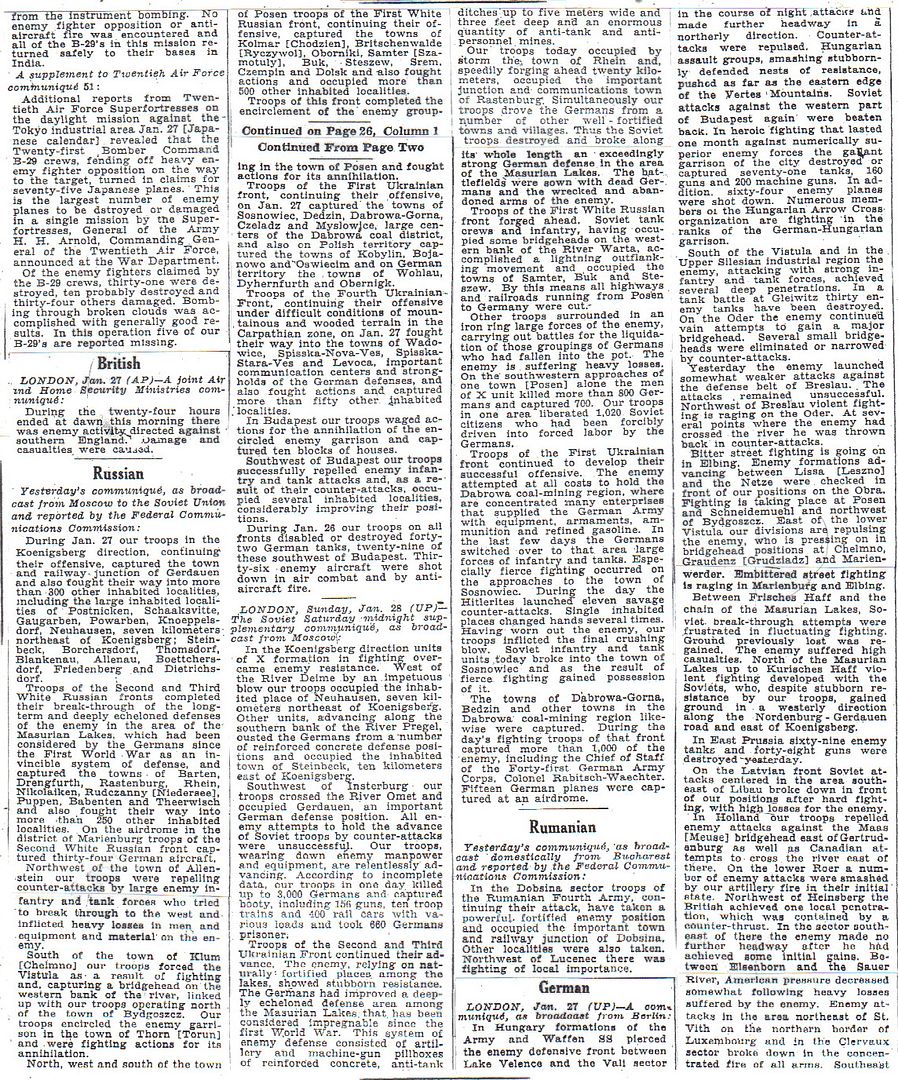
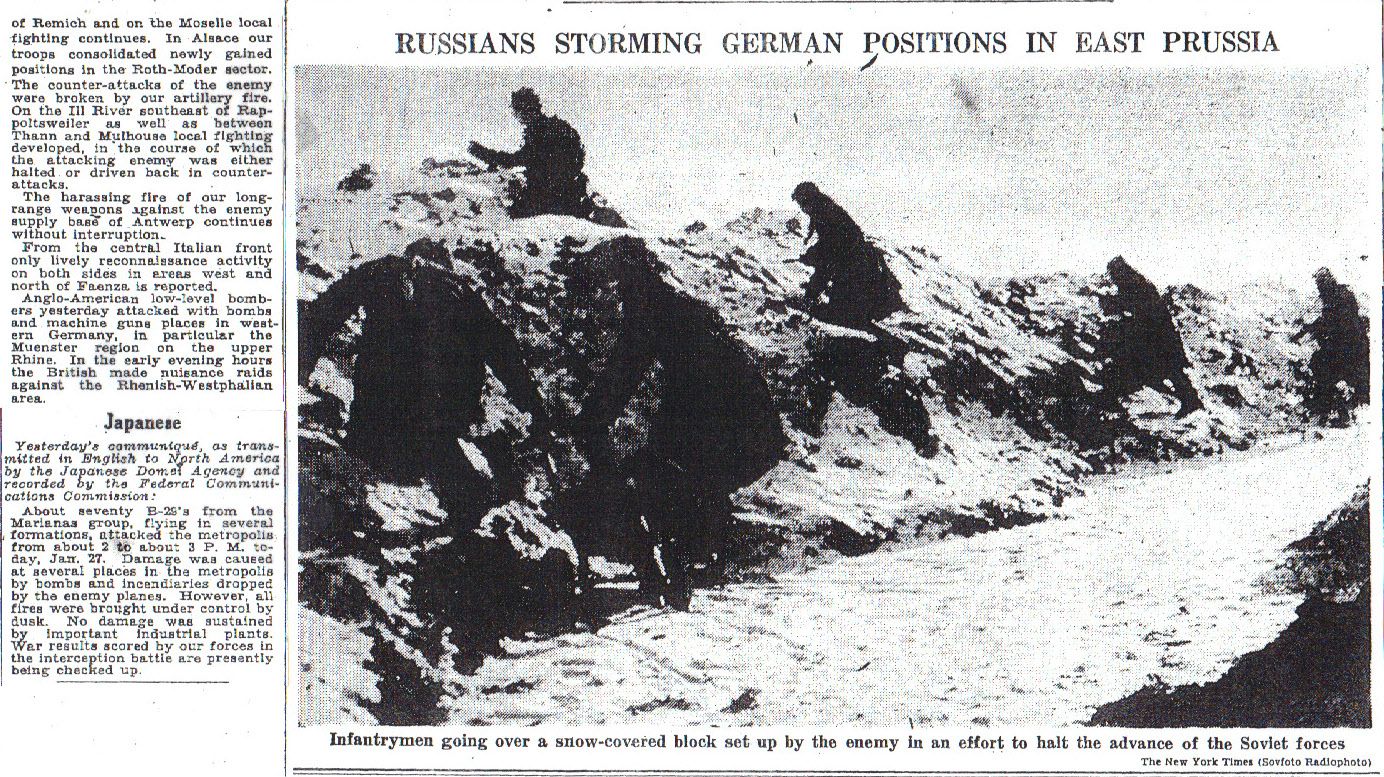
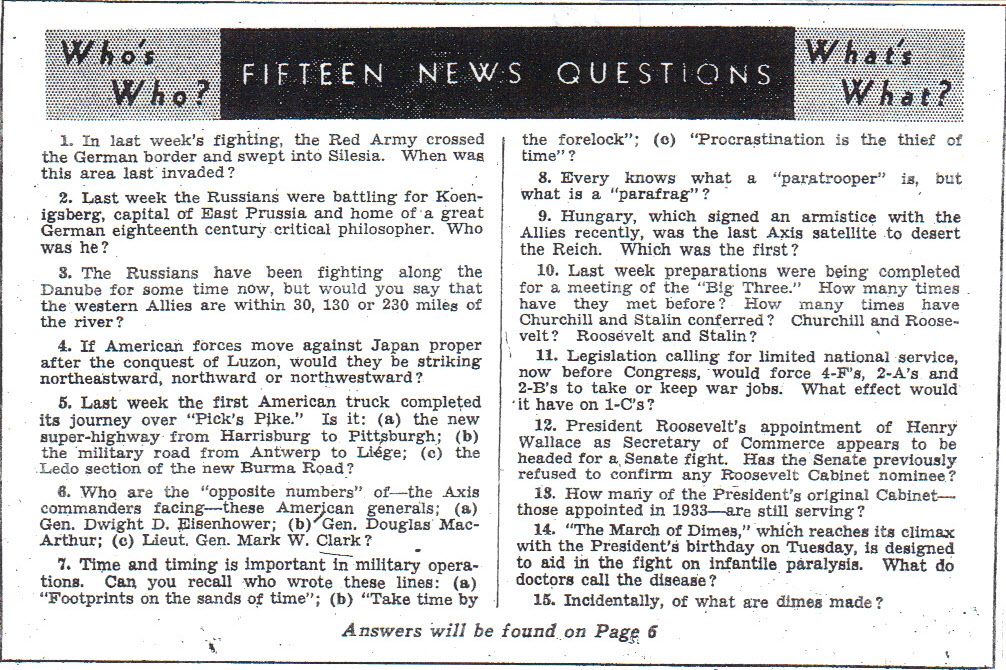


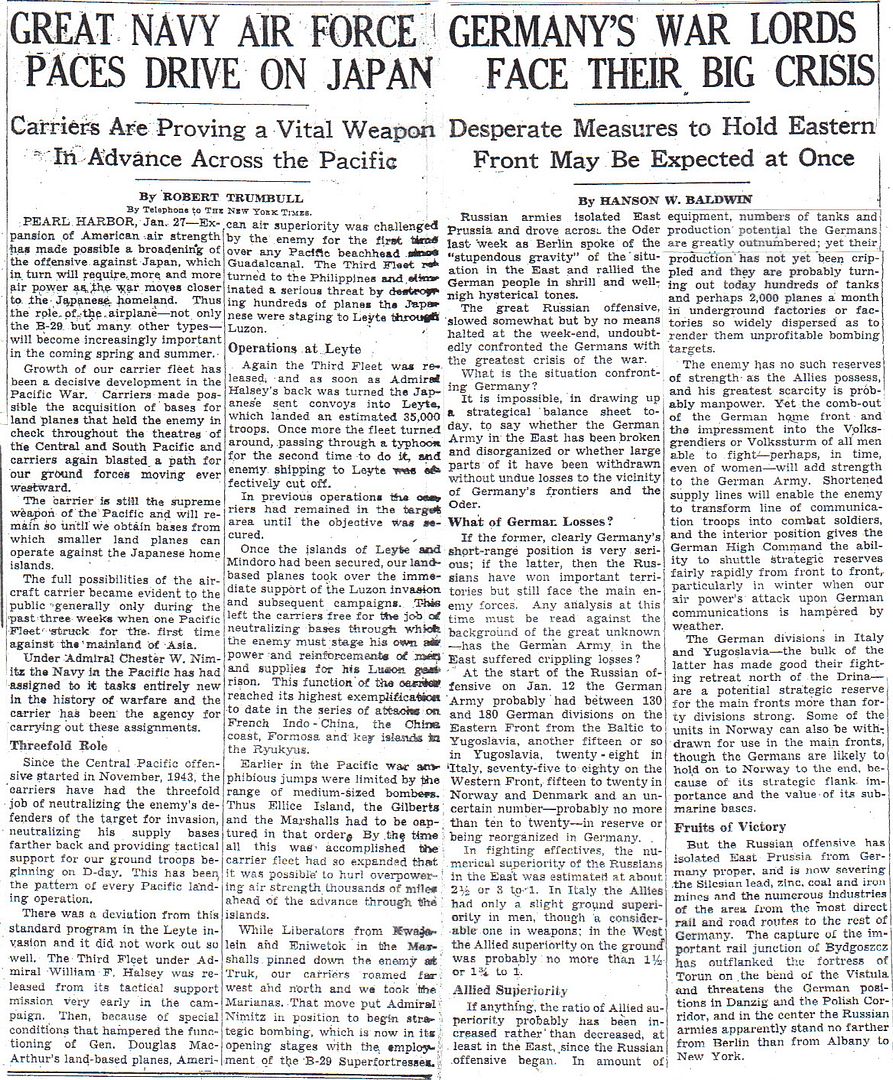
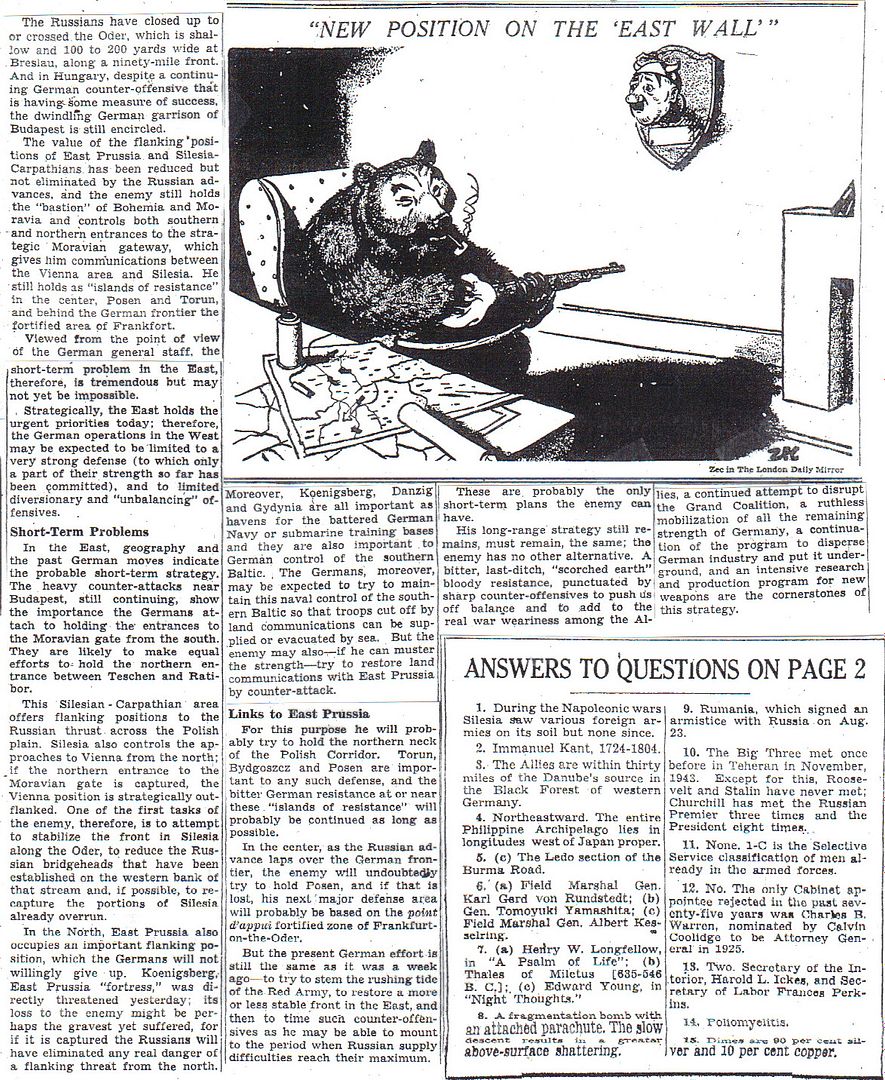
The News of the Week in Review
Fifteen News Questions – 14
The Far Eastern War Mounts Toward a Climax (map) – 15
Luzon’s Fall to Mark New Phase of the War (Shalett) – 16
Great Navy Air Force Paces Drive on Japan (Trumbull) – 17
Germany’s War Lords Face Their Big Crisis (Baldwin) – 17-18
“New Position on the ‘East Wall’” (cartoon) – 18
Answers to Fifteen News Questions – 18
http://www.etherit.co.uk/month/0/28.htm
January 28th, 1945 (SUNDAY)
UNITED KINGDOM: On it’s second flight in the UK the Lockheed P-80 fighter jet, YP-80A-LO , USAAF s/n 44-83026, msn 080-1005, crashes killing the pilot.
FRANCE: Versailles: Eisenhower returns the command of the US Ninth Army, temporarily given to Montgomery, to Bradley.
GERMANY: Berlin: Civilians are ordered to start digging anti-tank ditches around the city.
The 1st Belorussian Front enters Pomerania.
Allied PoWs are marshalled by their German captors in prison camp Stalag Luft III, near Sagan, in southeastern Germany to be marched 90 kilometres across frozen countryside to Luckenwalde, near Berlin.
From the memoirs of Tom Hough, Canadian fighter pilot: The order came with characteristic German terseness. All Allied prisoners, more than 1,000 aircrew from Canada, Britain and other Commonwealth countries, were to be ready to evacuate Stalag Luft III on 30 minutes’ notice.
Tom Hough of the Royal Canadian Air Force had been expecting it, but the news still hit him and his fellow prisoners, or “kriegies,” like a ton of bricks. “Hysteria reigned. The pervading feeling was of immense relief not unaccompanied by apprehension. Val started playing his guitar, and in a spontaneous excess of spirits we all started singing,” he wrote 40 years later in an unpublished memoir.
After packing his meagre belongings, Mr. Hough, a Spitfire pilot who had joined the RCAF in 1941 and served with the RAF squadrons and with the Royal Australian Air Force in Egypt, had crash-landed behind enemy lines in Italy. A prisoner of war for almost a year, he paraded with the rest of the men. It was very cold and snowing lightly.
Now known as “the long march,” the event was duplicated at many other camps.
Walking 15 or 20 kilometres per day will take its toll of the prisoners, many of whom had been in captivity for five years.
Mr. Hough said. “What would happen to those too ill to walk? Many of us were suffering from foot trouble. Socks were removed, carrying parts of burst blisters with them. An increasing number were developing painful limps; many had developed coughs and running noses.
Some had temperatures. Many had diarrhea or intestinal infections.”
It was also the coldest winter Germany had experienced in 50 years and hundreds of PoWs collapsed and perished by the wayside. Ironically, Mr. Hough and his mates also had to contend with Allied aircraft that mistook them for a German column. In one incident alone, RAF Typhoon fighter bombers strafed and killed 60 PoWs.
Despite the horrors of the march, a comic incident occurred when a German officer made an unusual appeal, Mr. Hough wrote. “’If the kriegie who has stolen [his] birthday goose from his staff-car does not return it forthwith, you’ll all have to sleep in the snow. If he returns it immediately, no questions will be asked.’ The word was that it was too late, but apparently the officer settled for a D-bar [chocolate] and an unstated number of cigarettes.” (Henry Sirotin) Article by Buzz Bourdon, Globe and Mail, Thursday, May 5, 2006. Page S9. Link
U-2535 commissioned.
Crewman from U-348 died near Gotenhafen. [Matrose Hermann Witthöft].
BULGARIA: Sofia: Prince Cyril of Bulgaria is sentenced to death for war crimes he committed when he was regent in 1943-44.
LITHUANIA: Memel is occupied by the Russians, completing their occupation of Lithuania.
POLAND: Konev’s Red Army troops capture the Dabrowa coal mining area and the towns of Beuthen and Katowice.
COMMONWEALTH OF THE PHILIPPINES: Three USMC R4D5 (DC-3; C-47 type) aircraft from Squadron VMR 152 navigated for a flight of SBDs from Peleliu to Luzon. They arrive Luzon on the 29th. The SBDs were sent to assist the army for their dive bomb capabilities. (Bob Austin - Marine, navigator)
CHINA: The first supply convoy reaches China from Burma, via the reopened Ledo Road.
CANADA: Patrol vessel HMCS MacDonald paid off and returned to Dept of Fisheries.
U.S.A.: Aircraft carrier USS Antietam commissioned.
Destroyers USS Everett F Larson and Fred T Berry launched.
ATLANTIC OCEAN: A German minesweeper collided with U-1163 off Dronthein in Norwegian waters, damaging the U-boat slightly.
"The death marches were, in many instances, extremely public.
This group of weakened prisoners from Dachau was photographed marching through a tiny Bavarian village on its way through Wolfratshausen.
Many of these prisoners cover their heads in order to protect themselves from the damp, chilly weather."
"SS leader Heinrich Himmler (right) shares a moment of conversation with his personal physician and masseur, Felix Kersten.
In the final days of the war, Kersten, who treated several of the Nazi leaders, served as an intermediary between representatives of the World Jewish Congress and the head of the SS.
At two meetings held at Kersten's estate outside of Berlin, Himmler eventually agreed to free about 10,000 women held at the Ravensbrück, Germany, concentration camp."
"These children at Auschwitz, liberated by the Soviet Army on January 27, 1945, show their tattooed arms to the photographer.
Everyone imprisoned in Auschwitz had his or her arm tattooed with an identification number.
This served two purposes.
First, it allowed camp officials to keep track of the thousands of prisoners in the camp.
Second, making the inmates into nameless units served to dehumanize them, both crushing the spirit of the prisoners and making it easier for their guards to avoid facing the humanity of their charges."
"These children, liberated from Auschwitz by the Soviet Army, had been subjected to savage 'medical' experiments that they were fortunate to survive.
Auschwitz doctor Horst Schumann sterilized men, women, and children by exposing them to extreme doses of radiation.
He burned most of them so badly that they were deemed unfit for work and sent to the gas chambers.
It is uncertain precisely what experiments these children underwent."
Not merely from Belgium, but also from the Lane Bryant ad on page 10.
Robinson is an old cavalry post and was the home of the "buffalo soldiers," the all-black segregated cavalry. It later became a Quartermaster post for mustering animals used by the Army. In WWII, Robinson hosted a German POW camp, from which many worked on nearby farms and ranches.
Today Ft. Robinson is a state park and museum. It's worth a visit if you're in the area. I found the horse hospital very curious. They had special stalls for the patients and a huge operating room with the biggest, most oddly shaped operating table I've ever seen.
I am also saddened by the revival of antisemitism in Europe. Throughout most of my life I thought that was unthinkable, that the horror of the Holocaust would always suppress it. As a student of history I guess I should have known better.
Still, the administration will not order the Army to give it back to its owners until October 1945, at which time a Supreme Court appeal will be dismissed as moot.
The experience embittered Sewell Avery, the man hauled out of his office feet first by soldiers. Some believe that experience played a role in his adopting ultra-conservative policies that let his post-War competition get ahead of Ward.
What man is capable of doing to his fellow man is beyond astonishing. The fact we need a Savior is beyond dispute.
Hold on to whatever evidence you have of the Holocaust because there are organizations out to question, deny, and delete the existence of anything called "The Holocaust."
Unfortunately, although the horrors of Nazi extermination camps are beyond belief, the Bible warns us that this WILL happen again and it will be worse. Jeremiah calls it "Jacob's Trouble" (Jer 30:7). Daniel describes this soon-coming day like this:
there shall be a time of trouble, such as never was since there was a nation even to that same time (Dan 12:1).
According to the Book of Revelation and other biblical prophecies, at some point in the not-too-distant future (I think it will be a few decades from now - probably sometime in the last half of this century), the whole world will turn against Israel and will kill two-thirds of what's left of the Jews in Israel. (The world is already showing this turn against the Jews.)
One-third of the Jews in Israel, those who have accepted Jesus as their Messiah, will escape as Daniel goes on to say
at that time thy people shall be delivered, every one that shall be found written in the book (id).
Jesus is coming soon to take His own out of here before all this comes crashing down. As the Bible says, NOW is the time for salvation. Everyone, including the Jews need to come to Jesus NOW to be spared from this truly frightening and terrible day that is also coming soon.
Thanks, Papa. Reminds me of the old Chinese curse, may you live in interesting times.
That’s the right way to look at it though, just like you said. We are living in prophetic times and it is exciting. Kathryn Kuhlman used to say the Bible is more up to date than tomorrow’s newspaper.
Heh, good one.
That was a charming maternity frock ... good for about 3 months, I should think. I had one in which I looked exactly like an eggplant.
I dunno—aren’t those two distracting daisies placed exactly where we men are never supposed to look? I’m confused...
The point is to draw your gaze toward her face (and bosom) and away from her belly.
“I see,” said the blind man, as he picked up his hammer and saw.
I’m a native Nebraskan, and I love Ft. Robinson. It has its own historic feel. To me, that area represents the real beginning of the West.
It’s where Crazy Horse and his band surrendered in 1877, and where he was later killed as he attempted to escape custody.
Here’s the Wikipedia entry:
http://en.wikipedia.org/wiki/Fort_Robinson
Fort Robinson is a former U.S. Army fort and a present-day state park. Located in the Pine Ridge region of northwest Nebraska, it is 2 miles (3.2 km) west of Crawford on U.S. Route 20.[3]
History
In August 1873, the Red Cloud Agency was moved from the North Platte River to the White River, near what is now Crawford, Nebraska, in the northwest corner of the state. The following March, the U. S. Government authorized the establishment of a military camp at the agency site. Home to some 13,000 Lakotas, some of them hostile, the Agency was a source of tension on the Great Plains.
The camp was named Camp Robinson in honor of Lt. Levi H. Robinson, who had been killed by Indians while on a wood detail in February. In May, the camp was moved 1.5 miles (2.4 km) west of the agency to its present location; the camp was renamed Fort Robinson in January 1878. Fort Robinson played a major role in the Sioux Wars from 1876 to 1890. The Battle of Warbonnet Creek took place nearby in July 1876. Crazy Horse surrendered here with his band on May 6, 1877. On September 5 that year, he was fatally wounded while resisting imprisonment.[4] A historic plaque marks the site of his death.
In January 1879, Chief Morning Star (also known as Dull Knife) led the Northern Cheyenne in an outbreak from the agency. Because the Cheyenne had refused to return to Indian Territory, where they believed conditions were too adverse for them to survive, the army had been holding them without adequate food, water or heat during the severe winter to try to force them into submission. Soldiers hunted down the escapees and killed most over the next several weeks. The event marked the end of the Sioux and Cheyenne Wars in Nebraska.
Fort Robinson in 2003
In 1885, the 9th Cavalry Regiment, nicknamed the Buffalo Soldiers, was stationed at Fort Robinson. This was an all-black unit. During the next several years, the fort was enlarged and military training was a major activity. From 1889-1890, Second Lieutenant Charles Young served here and later was reassigned to the regiment. A black pioneer officer who had graduated from West Point, he was the highest-ranking black in the US Army throughout his career and achieved the rank of colonel.[5] From 1887-1898, the fort served as regimental headquarters. The post gymnasium and theatre, built in 1904, provided entertainment for the soldiers.[1]
In 1919 at the end of World War I, Fort Robinson became the world’s largest quartermaster remount depot. It was used as a breeding and training center for horses and mules for the military. In addition, stallions owned by the military were used to breed with local stock to improve it. During World War II, the fort was the site of a K-9 corps training center. Later it was used to hold a German prisoner-of-war camp.
The army decided to abandon Fort Robinson in 1947; in the following year, it transferred the property to the U.S. Department of Agriculture (USDA), for its Beef Cattle Research Station. In the mid-1950s, efforts were made to preserve the fort as a historic site, prompted by the demolition of buildings. In 1955, the Nebraska State Historical Society began to acquire property on the fort; in 1956, they opened a museum on the site. The fort was declared a National Historic Landmark in 1960. The USDA closed its operation in 1971, transferring the property to the state of Nebraska.[1][3][6][7]
The fort is part of the Fort Robinson and Red Cloud Agency historic district, which includes Fort Robinson and the site of the second Red Cloud Agency (about 1.5 mi (2.4 km) to the east). The district also includes the Camp Camby site and the 1886 Percy Homestead.
The fort is managed by the Nebraska Game and Parks Commission, with some individual buildings operated by the Nebraska State Historical Society and the University of Nebraska. A quartermaster’s stores building is now used as a playhouse by Chadron State College.[1]
The Trailside Museum of Natural History is located inside Fort Robinson State Park. It is operated by the University of Nebraska State Museum.
Fort Robinson Museum
The Fort Robinson Museum is located in the 1905 post headquarters building. Exhibits focus on the fort’s history, including its role guarding the Red Cloud Agency from 1874 to 1877, up through the housing of World War II German POWs from 1943 to 1946.
There are many historic buildings and sites for viewing, including the 1904 blacksmith shop, the 1908 veterinary hospital, the 1887 officers’ quarters, the 1875 guardhouse and adjutant’s office, and the post cemetery. There is also a library with materials about Fort Robinson and military and western history available for research.
Disclaimer: Opinions posted on Free Republic are those of the individual posters and do not necessarily represent the opinion of Free Republic or its management. All materials posted herein are protected by copyright law and the exemption for fair use of copyrighted works.